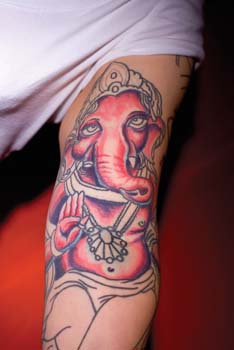
tattooing has traveled the globe to
appear, disappear and reappear —
currently on many a WSU student
and alum.
KNOWN AROUND THE WORLD as tatoeage, tatouage, tätowier, tatuaggio, tatuar, tatuaje, tatoos, tattueringar, tatuagens, tatoveringer, tattos and tatu, the ancient practice of tattooing is said to be more popular now than at any time in recorded history.
Current estimates say one in seven, or well over 44 million people in North America alone, have one or more tattoos.
Tattooing by puncture, with a sharp tool or needle that introduces a dye under the top layer of skin, was first practiced, so far as anyone knows, in ancient Egypt.
Clay dolls fashioned there are the earliest evidence of tattooing to have been preserved. Archaeological proof also exists that body markings by puncture tattoo were applied to human beings as well as clay figurines in Egypt between 4000 and 2000 BC.
It was from Egypt that the tattooing art traveled across the world, to appear, disappear and reappear throughout recorded history — and to emerge, skin deep, on a significant number of Wichita State students, faculty and alumni.
Notably, higher education seems to have guided the subject-matter choices of this tattooed population of Shockers.
Out of a group of 15 who showed up at the Fisch Haus one evening in May to be photographed for The Shocker, two showed off lettering in the original Greek of the first three words of Homer’s Iliad: “rage, sing, goddess.”





